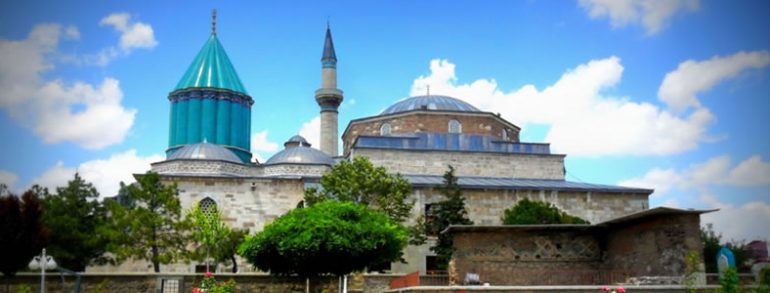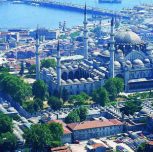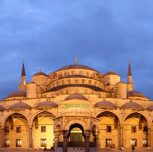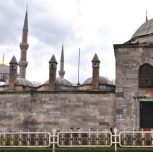Konya Mevlâna Müzesi
As the capital city of the Great Seljuk Empire (1037-1194), Konya, where Mevlâna lived, was then a very popular place in Anatolia. The current location of the Order in Konya was granted by the Seljuk Emperor Alâeddîn Keykubad to Mevlâna's father Bahaeddin Veled, who was then the chief scholar (Sultan-ül Ulema). When Bahaeddin Veled died in 1231, he was buried in the same land, which was originally a rose garden. "No domed mausoleum is better than the dome of the sky", said Bahaeddin and refused a mausoleum to be built for himself. After Mevlâna died in 1273, he was buried next to his father in the rose garden.
His son Veled and his disciples decided to build a mausoleum in 1274 on the same place, and established and developed the Mevlevi Order based on his masterpiece, the Mesnevi. A mescit (small mosque) and a domed semâhâne (ritual hall) were later added in the center. The popular name of Green Mausoleum (Yeşil Türbe or Kubbe-i Hadra), built on four big columns (elephant legs), was given after the sixteen-sided dome covered with green tiles was built in 1397. Besides the Mausoleum of Mevlâna, his father and his son, the mausoleums includes 64 more tombs. The expansion of the center continued until the 19th century.
The Order was closed after the special law (tekke ve zaviyeler kanunu) became effective in 1925 in the country. Converted to a museum in 1926 from Konya Museum of Antiquities, the name was changed to Konya Mevlâna Museum in 1956.
There are eighteen dervish cells with fireplaces, rebuilt by Sultan Murat III in 1584. The walls separating some of the cells were dismantled to create exhibition halls for antique rugs and textiles. Two cells are used as the library; one cell is decorated to exhibit a typical room for the Sheikh (Postnişin).
The mescit, built by Süleyman the magnificent, contains an exhibition of calligraphic works, rosaries, and books. The tomb of Mevlâna (Huzur-ı Pir) is entered from the Tilâvet Odası (a room where the Koran is read) through the silver doors donated in 1599 by Hasan Paşa (son of Grand Vizier Sokollu Mehmed Pasha). The oldest books of Mesnevi and Divân-ı Kebir were exhibited here.
The courtyard, entered through the dervish cells, includes a magnificent fountain. The kitchen (Matbah), located at the southwest, was built by Sultan Murat III in 1584.
The museum was extensively renovated between 1983 and 1987.
Location: It is located in the city center of Konya.
Hours: 9am to 5pm every day, Mondays: 10am to 5pm
Telephone: +90 332 351 12 15










